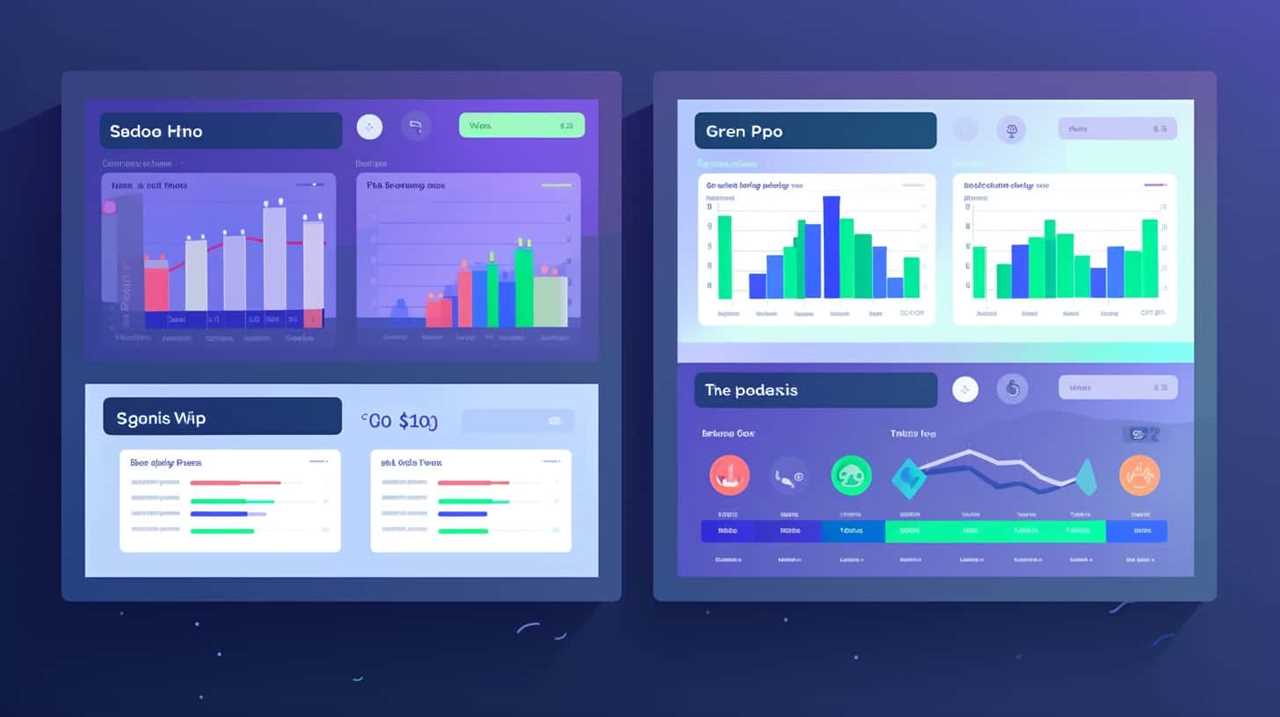Are you prepared to elevate your independent bookstore to new levels of success? The key to achievement is found internally: Google Ads.
Just like a well-crafted novel, a strategic Google Ads campaign can captivate your target audience and drive traffic to your store.
In this article, we’ll show you how to navigate the world of Google Ads, from setting up your account to creating compelling ad copy.
Get ready to write your own success story and watch your bookstore thrive!

Key Takeaways
- Target a specific audience to maximize online presence and reach potential customers.
- Tailor ads to resonate with potential customers by identifying demographics, interests, and online behaviors.
- Use relevant and high-performing keywords in well-structured ad groups for visibility.
- Monitor and analyze performance data to make data-driven adjustments and optimize ad campaigns.
Understanding Google Ads
Understanding Google Ads is essential for us to maximize our bookstore’s online presence and reach potential customers effectively. By harnessing the power of Google Ads, we can unlock a plethora of benefits that will propel our bookstore to new heights.
One of the key benefits of Google Ads is its ability to target a specific audience. With the right strategies in place, we can ensure that our ads are seen by individuals who are most likely to be interested in our bookstore and its offerings. This targeted approach allows us to optimize our advertising budget and get the most out of our investment.
Another advantage of Google Ads is its flexibility. We have the freedom to set our own budget, choose the duration of our campaigns, and even customize our ads to match our branding. This level of control empowers us to experiment, iterate, and refine our strategies until we find the winning formula that drives results.
Furthermore, Google Ads provides detailed analytics and insights. We can track the performance of our ads, monitor click-through rates, and analyze conversion data. Armed with this information, we can make data-driven decisions and continuously optimize our campaigns for maximum impact.

Setting Up Your Google Ads Account
Let’s get started on setting up our Google Ads account!
First, we’ll need to go through the account registration process, which involves choosing a username and password, as well as providing some basic information about our bookstore.
Once our account is up and running, we can move on to selecting our target audience and optimizing our ad campaigns to ensure maximum visibility and effectiveness.
Account Registration Process
To begin the process of setting up our Google Ads account, we need to go through the account registration procedure. This step is crucial as it ensures a smooth start to our advertising journey.

When registering, it’s important to be aware of common registration issues and know how to troubleshoot them. Sometimes, technical glitches or incorrect information can hinder the registration process, but by being prepared and following the best practices for account security and privacy, we can overcome these obstacles.
We must carefully choose a strong and unique password, enable two-factor authentication, and regularly update our account information to protect our data. By adhering to these guidelines, we can create a secure and efficient Google Ads account that sets us up for success.
Target Audience Selection
As we progress in setting up our Google Ads account, we can now delve into the crucial aspect of selecting our target audience for effective advertising. Target audience analysis and customer segmentation play a vital role in maximizing the success of our Google Ads campaign.
By understanding the needs, preferences, and behaviors of our potential customers, we can tailor our ads to resonate with them on a deeper level. Conducting thorough target audience analysis allows us to identify specific demographics, interests, and online behaviors that align with our bookstore’s offerings.

This knowledge enables us to create highly targeted ads that will capture the attention of our ideal customers and drive them to our store. By utilizing customer segmentation, we can further refine our targeting and deliver personalized ads that speak directly to different customer groups.
With this strategic approach, we can increase our chances of reaching the right audience and achieving our advertising goals.
Ad Campaign Optimization
Continuing with our target audience selection, we now move on to optimizing our ad campaign by setting up our Google Ads account. Here are four key steps to effectively optimize your ad campaign targeting and improve ad campaign performance:
- Keyword Research: Conduct thorough keyword research to identify the most relevant and high-performing keywords for your bookstore. This will help you reach potential customers who are actively searching for books or related topics.
- Ad Group Organization: Create well-structured ad groups based on themes or categories to ensure your ads are highly relevant to the search queries. This will improve your ad’s visibility and click-through rates.
- Ad Copywriting: Write compelling and concise ad copies that highlight the unique selling points of your bookstore, such as a wide range of genres, personalized recommendations, or exclusive events. This will entice potential customers to click on your ads.
- Conversion Tracking: Set up conversion tracking to measure the success of your ad campaign. By tracking key metrics, such as conversions, clicks, and impressions, you can assess the effectiveness of your ads and make data-driven optimizations.
Defining Your Target Audience
Our first step in writing our success story with Google Ads for independent bookstores is to clearly define our target audience. To create effective ad campaigns, we must conduct thorough target audience research and implement customer segmentation strategies. By understanding the unique characteristics, preferences, and behaviors of our potential customers, we can tailor our marketing messages and reach the right people at the right time.

Target audience research involves gathering data and insights about our customers, such as their demographics, interests, and online behavior. This information allows us to identify specific segments within our audience and create personalized campaigns that resonate with each group. Customer segmentation enables us to deliver relevant ads, increase engagement, and ultimately drive conversions.
As independent bookstores, we need to focus on attracting book lovers who appreciate the unique experience of browsing physical stores and discovering hidden literary gems. Our target audience may include avid readers, book club enthusiasts, and literary enthusiasts who value the personal touch and expert recommendations that independent bookstores provide.
Choosing the Right Keywords
When it comes to choosing the right keywords for our Google Ads campaign, we need to ensure that they’re relevant to our bookstore and the products we offer. By selecting keywords that accurately represent our inventory and appeal to our target audience, we can increase the chances of reaching potential customers who are specifically looking for what we’ve to offer.
Additionally, it’s important to focus on local keywords to target customers in our area and drive foot traffic to our physical store.

Relevant Keyword Selection
To ensure maximum effectiveness of our Google Ads campaigns, we must carefully select the most relevant keywords that will drive targeted traffic to our independent bookstore.
When conducting relevant keyword research, we need to consider the following key elements to optimize our ad campaign strategies:
- Search Volume: Identify keywords with high search volume to reach a larger audience and increase visibility.
- Relevance: Choose keywords that accurately reflect the products and services offered by our bookstore to attract customers who are specifically interested in what we’ve to offer.
- Competition: Analyze the competition for each keyword to determine the level of difficulty in ranking higher in search results.
- Long-tail Keywords: Utilize long-tail keywords to target niche audiences and increase the chances of conversion.
Targeting Local Customers
In order to target local customers effectively, we focus on selecting the right keywords. When it comes to local marketing strategies, using specific and location-based keywords is crucial. By incorporating these keywords into our Google Ads campaigns, we can ensure that our ads are shown to the right audience in the right location.
We also take into account the importance of community engagement in our keyword selection process. By understanding the interests and needs of our local community, we can tailor our keyword choices to align with their preferences. This not only increases the relevance of our ads but also enhances our connection with potential customers.

Now that we’ve identified the right keywords, let’s move on to the next step: creating compelling ad copy that will capture the attention of our target audience.
Creating Compelling Ad Copy
Crafting engaging ad copy is essential for driving success in Google Ads campaigns for independent bookstores. To help you create compelling ad copy that captures the attention of potential customers and drives them to take action, we’ve compiled a list of four effective strategies:
- Use compelling ad headlines: The headline is the first thing that users see when they come across your ad. Make it attention-grabbing and relevant to your target audience’s interests and needs.
- Optimize your ad copy: Make sure your ad copy is clear, concise, and persuasive. Highlight the unique selling points of your bookstore, such as a wide selection of genres, knowledgeable staff, or special events.
- Include a strong call-to-action: Encourage users to take the desired action, such as visiting your website, making a purchase, or signing up for a newsletter. Use action-oriented language and create a sense of urgency.
- Test and refine: Continuously monitor the performance of your ad copy and make adjustments as needed. Experiment with different headlines, descriptions, and calls-to-action to find what resonates best with your target audience.
Designing Eye-Catching Ad Images
Let’s talk about how to create eye-catching ad images that will captivate your audience and drive them to take action.
Visual storytelling techniques can help you create images that evoke emotions and resonate with your target customers.

We’ll also explore image optimization strategies to ensure that your ads load quickly and look great on any device.
Lastly, we’ll discuss how to use ad visuals to reinforce your branding and create a cohesive experience for your customers.
Visual Storytelling Techniques
We employ captivating visual storytelling techniques to design eye-catching ad images. Here are four engaging narrative strategies we use to create compelling visuals for our Google Ads:
- Emotionally evocative imagery: We carefully select images that evoke strong emotions and resonate with our target audience. By using visuals that capture attention and elicit an emotional response, we’re able to create a connection between the viewer and the ad.
- Storytelling through visuals: We believe in the power of a good story. Our ad images are designed to tell a story and engage the viewer’s imagination. By creating a narrative within the visual, we can capture the viewer’s interest and leave a lasting impression.
- Minimalist design: We understand the importance of simplicity in visual communication. Our ad images feature clean and minimalist designs that allow the message to be easily understood. By keeping the visuals clutter-free, we ensure that our ads are visually appealing and easy to comprehend.
- Bold and vibrant colors: We utilize bold and vibrant colors to grab attention and create visual impact. By using colors that stand out, we’re able to make our ads visually appealing and increase their chances of being noticed.
Image Optimization Strategies
Continuing with our discussion on visual storytelling techniques, let’s now delve into the topic of image optimization strategies for designing eye-catching ad images.

When it comes to creating ads for your independent bookstore, it’s crucial to optimize your images to increase ad visibility. To achieve this, there are a few key techniques to keep in mind.
First, make sure your images are high quality and visually appealing. Use vibrant colors and clear, crisp visuals to capture the attention of your target audience.
Next, consider the composition of your images. Use the rule of thirds to create a balanced and visually pleasing layout.
Additionally, don’t forget to optimize your image file sizes to ensure fast loading times.

Branding Through Ad Visuals
To effectively brand your independent bookstore through ad visuals, it’s important to design eye-catching images that capture the attention of your target audience. Here are four key strategies for creating compelling ad designs that will enhance your visual branding:
- Use vibrant colors and striking typography to grab attention and convey your bookstore’s personality.
- Incorporate captivating images of your store, books, or literary themes to evoke curiosity and interest.
- Keep the design clean and uncluttered, focusing on the most essential information and a clear call-to-action.
- Experiment with different ad formats, such as carousel ads or interactive elements, to engage your audience and stand out from the competition.
Optimizing Your Landing Page
How can we ensure that our landing page is optimized for maximum conversions? One way to achieve this is through conversion tracking and A/B testing. Conversion tracking allows us to measure the success of our landing page by tracking the actions that users take, such as making a purchase or filling out a form. By analyzing this data, we can identify areas for improvement and make data-driven decisions to optimize our landing page.
Another effective strategy is A/B testing, where we create two versions of our landing page and test them against each other to see which one performs better. This helps us understand what elements on our page are resonating with our audience and driving conversions. By constantly testing and iterating, we can refine our landing page to maximize its effectiveness.
To give you a clear idea of how to optimize your landing page, here is a table outlining some key elements to consider:

| Element | Optimization Tips |
|---|---|
| Headline | Create a compelling and clear headline that grabs attention and communicates value. |
| Call-to-Action | Use a strong and persuasive call-to-action that prompts users to take the desired action. |
| Design | Ensure that your landing page is visually appealing, user-friendly, and consistent with your brand. |
| Form | Keep your form simple and easy to fill out, asking for only essential information. |
| Loading Speed | Optimize your landing page for fast loading speed to prevent users from bouncing. |
Setting a Budget for Your Ads
Setting a budget for our ads is crucial for the success of our independent bookstore. With Google Ads budget planning, we can ensure that our advertising efforts are effective and efficient. Here are four key points to consider when setting our ad budget:
- Define our goals: Before allocating our budget, we need to clearly define our advertising goals. Are we looking to increase brand awareness, drive website traffic, or boost book sales? By identifying our objectives, we can allocate our budget accordingly and measure the success of our campaigns.
- Research our target audience: Understanding our target audience is essential for maximizing ad spend. Conduct thorough research to identify the demographics, interests, and online behavior of our potential customers. This information will help us create targeted ads that resonate with our audience, leading to higher conversion rates.
- Consider competition and seasonality: Analyze our competitors’ advertising strategies and adjust our budget accordingly. Take into account seasonal trends in the book industry and allocate more budget during peak periods to capitalize on high demand.
- Monitor and optimize: Continuously monitor the performance of our ads and adjust our budget accordingly. Analyze metrics such as click-through rates, conversion rates, and return on ad spend. By optimizing our campaigns based on real-time data, we can make the most of our ad budget and drive the desired results.
Monitoring and Analyzing Performance
We closely monitor and analyze the performance of our Google Ads campaigns to ensure optimal results for our independent bookstore. Tracking ad performance is crucial in understanding the effectiveness of our marketing efforts and making data-driven decisions. By regularly monitoring campaign performance, we can identify areas of improvement and make necessary adjustments to maximize our return on investment.
One effective way we track and analyze our ad performance is through the use of a performance dashboard. This dashboard provides us with real-time data on key metrics such as click-through rates, conversion rates, and cost per acquisition. By visualizing this information in a clear and concise manner, we can quickly assess the success of our campaigns and identify any areas that require attention.
Additionally, we utilize a tracking code to monitor the performance of specific ads and keywords. This code allows us to see which ads are generating the most clicks and conversions, enabling us to optimize our campaigns for better results. By regularly reviewing this data, we can make informed decisions on ad placements, bidding strategies, and ad copy to continually improve our campaign performance.

Tracking and analyzing our Google Ads performance is a continuous process that requires ongoing monitoring and adjustment. By staying vigilant and using data to guide our decision-making, we can ensure that our campaigns are delivering the desired results and driving success for our independent bookstore.
| Metric | Description | Importance |
|---|---|---|
| Click-through rate (CTR) | The percentage of people who click on our ads | Indicates ad relevance |
| Conversion rate | The percentage of people who complete a desired action | Measures campaign success |
| Cost per acquisition | The average cost of acquiring a customer | Determines campaign ROI |
Table 1: Key Metrics for Monitoring Campaign Performance
Making Data-Driven Adjustments
To further optimize our Google Ads campaigns, we rely on data-driven adjustments to continuously improve our independent bookstore’s marketing efforts. Data analysis and campaign tracking play a crucial role in guiding these adjustments.
Here are four key ways we leverage data to drive success:

- Performance Evaluation: We closely monitor the data to evaluate the performance of our ad campaigns. By analyzing key metrics such as click-through rates, conversion rates, and cost per acquisition, we can identify areas of improvement and make data-driven decisions.
- Targeting Refinement: Through data analysis, we gain insights into the demographics, interests, and behaviors of our target audience. This information allows us to refine our targeting strategies and ensure that our ads are reaching the right people at the right time.
- Ad Optimization: By analyzing the performance of individual ads, we can identify which ones resonate most with our audience. We use this data to optimize our ad copy, imagery, and calls to action, maximizing the effectiveness of our campaigns.
- Budget Allocation: Data analysis helps us allocate our ad budget strategically. By identifying the campaigns and keywords that generate the highest return on investment, we can allocate more resources to those areas and optimize our budget allocation.
Expanding Your Ad Campaigns
After making data-driven adjustments to our Google Ads campaigns, it’s now time to expand our ad campaigns to further amplify our success. By expanding our reach and increasing conversions, we can maximize the impact of our advertising efforts.
To expand our reach, we can consider targeting new keywords and demographics that align with our target audience. Conducting thorough keyword research and analyzing market trends can help us identify untapped opportunities. By broadening our targeting parameters, we can increase our chances of reaching potential customers who may be interested in our bookstore.
Furthermore, we can explore different advertising channels and formats to expand our reach. This could include display ads, video ads, or even social media advertising. By diversifying our ad placements, we can reach a wider audience and increase the chances of attracting new customers to our bookstore.
In addition to expanding our reach, we should also focus on increasing conversions. This can be achieved by optimizing our landing pages and improving the user experience. By ensuring that our website is user-friendly, responsive, and visually appealing, we can encourage visitors to take the desired action, such as making a purchase or signing up for our newsletter.

In conclusion, expanding our ad campaigns is crucial for increasing our reach and conversions. By targeting new keywords, demographics, and exploring different advertising channels, we can attract more customers to our bookstore.
In the next section, we’ll discuss the importance of leveraging Google ad extensions to further enhance our advertising strategy.
Leveraging Google Ad Extensions
Using the right Google ad extensions can greatly enhance the effectiveness of our advertising strategy for independent bookstores. These extensions provide additional information and functionality to our ads, making them more engaging and compelling for potential customers.
Here are four ways we can leverage ad extensions to maximize our ad performance:

- Sitelink Extensions: These extensions allow us to include additional links in our ads, directing customers to specific pages on our website. By providing direct access to relevant information or promotions, we can increase the chances of conversion and encourage customers to explore further.
- Call Extensions: With call extensions, we can add a phone number to our ads, making it easy for customers to contact us directly. This not only increases customer convenience but also helps us measure the effectiveness of our ads by tracking the number of calls generated.
- Location Extensions: For brick-and-mortar bookstores, leveraging location extensions is crucial. By displaying our store address and a map, we can attract local customers who are searching for nearby bookstores. This extension also helps us measure the foot traffic generated from our ads.
- Review Extensions: Positive reviews can significantly influence a customer’s decision-making process. By showcasing favorable reviews in our ads, we can build trust and credibility, increasing the likelihood of conversion.
Success Stories From Independent Bookstores
We’ve seen remarkable success stories from independent bookstores utilizing Google Ads. These stories are a testament to the effectiveness of smart marketing strategies and the power of targeted advertising. Let me share a few examples of how independent bookstores have used Google Ads to achieve outstanding results:
| Success Story | Marketing Strategy |
|---|---|
| Story 1 | Social Media Integration |
| Story 2 | Local SEO Optimization |
| Story 3 | Remarketing Campaigns |
In Story 1, a small independent bookstore integrated their Google Ads with their social media platforms, creating a cohesive and engaging online presence. By targeting their ads to users who had expressed an interest in books, they were able to drive traffic to their website and increase sales.
Story 2 highlights the importance of local SEO optimization. By utilizing Google Ads’ location targeting feature, an independent bookstore was able to reach potential customers in their area. This strategy resulted in higher foot traffic and increased visibility within the local community.
Lastly, Story 3 showcases the effectiveness of remarketing campaigns. An independent bookstore utilized Google Ads to retarget users who had previously visited their website but did not make a purchase. By serving them personalized ads, they were able to bring these potential customers back and convert them into loyal patrons.

These success stories demonstrate the power of Google Ads in helping independent bookstores thrive in a highly competitive market. By implementing strategic marketing strategies, these bookstores have been able to reach their target audience, drive sales, and create a lasting impact.
Frequently Asked Questions
How Can I Effectively Track the Performance of My Google Ads Campaign for My Independent Bookstore?
To effectively track the performance of our Google Ads campaign for our independent bookstore, we measure metrics and analyze data. By improving click through rates and targeting the right audience, we can optimize ad performance.
What Are Some Common Mistakes to Avoid When Setting up My Google Ads Account for My Bookstore?
To maximize ROI and avoid pitfalls when setting up your Google Ads account for a bookstore, we must be cautious of certain common mistakes. These can impact campaign performance and hinder success.
How Do I Determine the Appropriate Budget for My Google Ads Campaign?
To determine the appropriate budget for our Google Ads campaign, we need to consider our campaign goals and carefully calculate our ad spend. It’s crucial to strike a balance between reaching our target audience and managing our resources effectively.

Are There Any Specific Strategies or Tips for Optimizing the Landing Page of My Bookstore’s Website?
Optimizing landing page design and implementing effective conversion strategies are crucial for maximizing the success of your bookstore’s website. We’ll guide you through specific tips and strategies to help you achieve your goals.
Can You Provide Examples of Successful Independent Bookstores That Have Used Google Ads to Boost Their Sales?
Successful independent bookstores like Powell’s Books and Strand Bookstore have harnessed the power of Google Ads to skyrocket their sales. Their success stories serve as inspiration for others looking to boost their bookstore’s revenue through targeted online advertising.
Conclusion
In the ever-changing landscape of digital advertising, independent bookstores are finding success with Google Ads. By understanding their target audience, choosing the right keywords, and creating compelling ad copy, these bookstores are reaching new customers and driving sales.
With data-driven adjustments and the use of Google Ad Extensions, they’re able to expand their ad campaigns and maximize their reach. These success stories prove that with the right strategy and a touch of creativity, independent bookstores can thrive in the online marketplace.

So, don’t let your story go untold – harness the power of Google Ads and write your own success story today.










